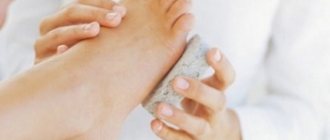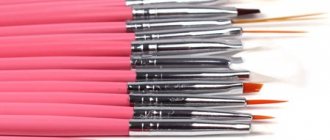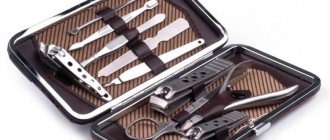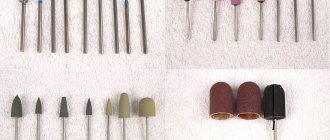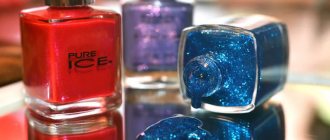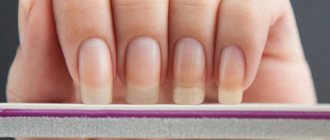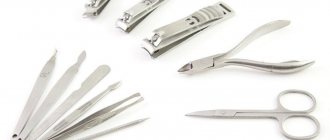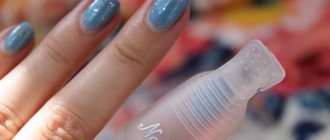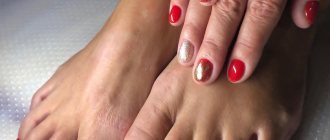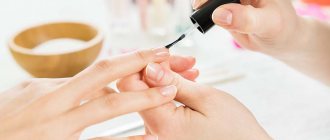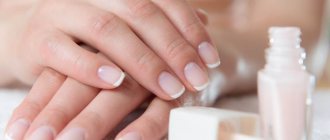What requirements for sterilization does SanPiN impose?
Requirements for cleanliness and processing are established by sanitary rules that replaced SanPiN - SP 2.1.3678-20. They say that all manicure and pedicure procedures that can damage the skin or nail plate must be performed by the master with sterile instruments.
Alternatively, a disposable instrument can be used. These are, for example, abrasive attachments for base files and buffs or sand caps. They are thrown away after each client.
According to sanitary rules, disinfection is carried out in stages. And we must not confuse disinfection and sterilization. The first refers to chemical cleaning, which is used to carry out primary processing. Sterilization of manicure instruments according to SanPin involves the destruction of all dangerous microorganisms.
Types of attachments required for hardware manicure
The attachments for the apparatus used for manicure vary not only in abrasiveness. They have different tip diameters and rotation speed limits and are designed to perform a variety of operations.
Each nozzle has its own purpose
Modern manufacturers of manicure machines offer many different attachments. They can be divided into three large groups, depending on their main purpose:
- filing and shaping nails;
- polishing the cut and surface of the nail plate;
- final polishing and shine.
In addition, there is a narrower division of nozzles according to other criteria.
Manicure cutters - video
What stages does complete disinfection include?
To achieve proper sterility of the instrument, processing is carried out in four steps.
Mechanical cleaning
After each client, instruments are washed under running water. Pre-cleaning allows you to wash away skin particles and dust from filing the nail plate from smooth and abrasive surfaces.
Treatment with a disinfectant
The instruments are placed in a bath or box with a disinfectant solution. For disinfection, drugs with antiviral and antifungal properties are used. The exposure time is selected according to the instructions for the composition. Concentrates are diluted in proportions corresponding to treatment for hepatitis. After disinfection, the instruments are washed again with water.
Sometimes, instead of a solution, disinfectants are used in the form of an aerosol, for example Bacillol, Estilodez, Miroseptic or wiping. This helps to quickly disinfect surfaces.
Pre-sterilization treatment
Pre-sterilization treatment or chemical sterilization is often combined with disinfection. For cleaning, similar disinfecting solutions with antiviral and sporicidal effects are used, where the instruments are immersed for a specified time.
Sterilization
Washed and dried instruments are placed in a craft bag with a special indication and sent to the sterilizer. Temperature and time are selected based on the material.
All stages of sterilization of manicure instruments take at least 1.5 hours. Therefore, the master should always have disinfected kits in stock. Clean instruments are sent to the UV cabinet or stored in the same craft bag that is opened in front of the client.
Processing tools that are used by several people
Even if you are doing a manicure for your family or friends, the tools need to be carefully treated. This must be done in three stages: cleaning, disinfection and sterilization.
Mechanical cleaning of contaminants
As when processing individual instruments, soap is suitable here, you can also use dishwashing detergent or liquids with antimicrobial additives. Wash the instrument in warm water, then rinse off any remaining product.
Disinfection
This stage allows you to get rid of germs on surfaces and infectious agents. At home, it can be done in different ways: treated with chemicals, cleaned with an antiseptic, or boiled. Let's start with chemical treatment.
Treatment with chemicals
This is a method in which metal objects are kept in a disinfectant solution. The holding time depends on the composition of the solution, and you should remove objects with gloves or tweezers to protect yourself from the harmful effects of chemicals. Let's look at some chemical disinfectants.
- Estilodez An effective and inexpensive remedy. Kills HIV and hepatitis viruses, as well as tuberculosis bacteria and fungi. Also suitable for treating work areas and towels.
- MultiDez Another inexpensive product that contains fewer chemicals, but works great. Kills viruses, fungi and most bacteria. Used in medical institutions, sports complexes and catering establishments.
- Alaminol Effective, but not toxic; if it gets on your skin, you can simply wash it off with water. Fights fungi, viruses, rotaviruses and HIV.
- Neosteril This product copes with fungi, HIV viruses, bacteria, etc., also has a healing effect and is suitable for treating wounds and cuts. Neosteril does not cause allergic reactions and does not require washing the instrument after treatment.
- Desecon Thoroughly removes skin particles, dirt, cream and oil. The higher the water temperature, the more effective Dezecon works.
Antiseptic treatment
Products with an antiseptic effect are medical and cosmetic. As a rule, it is written on the packaging if they are suitable for processing manicure tools. They often have a strong odor, but you can choose a product with fragrances that soften it.
Cleansing lotion with antibacterial effect Sanitizer Green tea ParisNail 950 ml
ATTENTION!
After treating instruments with chemicals or an antiseptic, they must be washed under running water, except for products that do not require this.
Boiling
This is a popular way to process tools at home. There is an opinion that in boiling water all microbes and harmful bacteria die, but this is not so. Boiling disinfects instruments, but does not sterilize them. Sterility is achieved at much higher temperatures than 100 degrees.
Sterilization
Unlike disinfection, sterilization completely destroys all harmful microorganisms, leaving the surface of the instrument perfectly clean and safe. During sterilization, all pathogenic and non-pathogenic microorganisms, including spores, are destroyed. The likelihood of transmitting an infection after such a procedure is completely excluded.
Like the previous processing steps, sterilization can be carried out in different ways depending on your capabilities. First, let's look at how tools are sterilized in manicure studios.
How do they sterilize instruments in manicure salons?
The main equipment used in studios is a dry-heat oven and an autoclave.
A dry-heat oven (also called an “air sterilizer”) is similar in its operating principle to an oven. In it, instruments are treated with dry hot air. The products are sent to dry heat for 1 hour, where under the influence of high temperatures (about 180-190 degrees) all harmful microorganisms dry out and die.
An autoclave sterilizes instruments using steam under pressure. As a result, microorganisms die from high temperature (110-140 degrees) and rupture of the shells by pressure. At the same time, processing time is reduced to 20-30 minutes!
Each device has its own advantages and disadvantages. The dry-heat oven wins in terms of cost. Also, dry air treatment in it is not as harmful to metal instruments as steam treatment in an autoclave, which causes them to corrode. However, non-heat-resistant instruments cannot be sterilized in dry heat, and processing takes a lot of time. The autoclave is suitable for glass and silicone materials; the tools in it are less dull, but it will also cost more.
Dry-heat cabinet GP-10 MO
Drying oven 3859 ruNail
Air sterilizer "Ferroplast-10"
Basic rules of disinfection and sterilization
When disinfecting and sterilizing instruments, follow a few simple but important rules:
- use broad-spectrum solutions that simultaneously destroy viruses, bacteria and fungi - for example Multidez, Optimax, Aktibor, Nanodez, Almadez, Glutaral, Sidex and others;
- use products that allow you to quickly process instruments, do not damage medical and stainless steel, dissolve well in water and are easily washed off;
- follow the recommended concentration and soak time in the solution, and also make sure that it completely covers the instruments - this will make disinfection effective;
- be sure to rinse off the remaining disinfectant solution with running water and dry the instruments before sterilization so that lime stains and rust do not appear on them;
- Choose a sterilization method and equipment that matches your loading and processing needs, then you can disinfect all instruments and have the required supply of kits.
How to remove gel polish with a machine yourself at home
You should remove gel polish yourself at home using a device according to a clear algorithm:
- Remove topcoat and decorative/color coating. The movements are performed long, longitudinally, in the direction from the cuticle to the end of the nail. The speed is optimal, only the middle part of the plate is processed, the middle part of the cutter is used in the work (the most convex part - the “belly”).
- Move to the side parts of the nail and remove the gel polish here with the tip of the cutter. The rotation speed of the tool does not decrease; you need to monitor the pressure - it should be uniform, without applying any effort.
- The end of the nail (free edge) is processed with the middle of the cutter; it should not be positioned vertically in relation to the plate, but at an angle of 10-15 degrees. This completes part of the work of removing the decorative coating.
- Clean the base layer with a cone-shaped corundum cutter. The speed should be reduced to 10 thousand per minute.
- The final stage is to walk over the surface of the plate with a buffer with an abrasiveness of 240 grit without applying any effort (without pressure).
Watch this video on how to remove gel polish with a machine at home:
What are the sterilization methods?
To completely disinfect manicure instruments, different types of equipment are used, which differ from each other in the method of exposure.
Steam in autoclave
Suitable for metal, glass, heat-resistant polymers. For processing, hot saturated steam under high pressure is used, the temperature of which is about 1300C. The process lasts no more than 15-20 minutes, which saves time and is convenient when working in a salon with very high traffic.
The disadvantages of the equipment include the price - good autoclaves cost about 80-100 thousand rubles, are large in size and operate on distilled water.
Thermal in dry heat
Used for tools that can withstand high temperature processing. Sterilization takes place under the influence of dry steam heated to 150-2500C. The calcination procedure takes from 30 minutes to 2 hours.
Dry fires are compact and affordable. When choosing equipment, you need to ensure that the model allows sterilization in craft bags and that they do not burn.
Ultraviolet in a UV sterilizer or washer
Used for instruments made of different materials, including those that do not allow heat treatment. The bath is filled with a cleaning solution. Dangerous microorganisms are destroyed by high frequency ultrasonic waves.
UV washers are convenient. They can be used not only for sterilization, but also for storing finished instruments. The disadvantages include the fact that ultrasound cannot cope with HIV and hepatitis viruses.
Airy in glasperlen
Suitable for metal only. The treatment is carried out by heating quartz balls with hot air, into which the tool is immersed. The impact is short-term, lasting about 20 seconds.
Glasperlens allow sterilization to be carried out very quickly. However, they are limited in use and require control of the treatment area, since immersion may not be complete.
Criteria for selecting nozzles
For a successful manicure, you need to select only high-quality attachments for the device. Some of them are quite expensive, but they are reliable, safe and will last a long time.
An important feature of a good cutter is the absence of severe overheating. During intensive work at high speed, the temperature of the nozzle increases, but only slightly. As a result, the nails will be protected from negative thermal effects.
The minimum kit for home hardware manicure includes several different cutters. The kit could be like this:
- medium-diameter bur - will help remove dead skin that has grown around the nail plate;
- rough cylinder - will give the nails the required shape (oval, rectangular);
- fissure (pointed) nozzle - used for grinding nail ridges, as well as in pedicure;
- needle-shaped cutter - used to remove cuticles in hard-to-reach places (on the sides of the nail).
The width of the nozzle is selected depending on the width of the nails
Disposable sand caps or felt cutters are useful as auxiliary attachments.
Each nozzle consists of a shank and a working tip with abrasive. The length of the shank must match the size of the clamp on the handle of the device. The nozzle must be inserted all the way and held firmly in the socket. The diameter of the shank is standard and is 2.35 mm. The slightest deviations from this figure will increase the vibration of the device handle, creating inconvenience during operation.
Selecting attachments for hardware manicure according to shape is very simple:
- drop-shaped, conical and cylindrical have a large lateral surface area; they will help cut the cuticle and polish the nail ridges;
- disc and cylindrical with coarse abrasive adjust the length and shape of the cut of the nail plate;
- conical rounded ones are designed for polishing the surface of the nail;
- soft cutters made from artificial or natural materials are necessary for polishing.
A soft nozzle made of cotton or silicone can be successfully replaced with a buff
What you need to buy to properly disinfect and sterilize instruments
A master working in a salon or at home needs a set of tools, consumables and equipment for sterilization.
The kit should include:
- disinfectant for primary cleaning and pre-sterilization treatment of instruments in solution;
- sterilization bags, preferably with an indicator that changes color during processing;
- special equipment - a dry heater for disinfection or an ultrasonic cleaner for cleaning and storing files, buffs and other tools that cannot tolerate high temperatures.
DO NOT FORGET
antiseptics for hand disinfection and surface treatment products. For manicures and pedicures to be safe, everything needs to be cleaned.
At the Sterille Store you will find antiseptic and disinfectants, craft bags and sterilization equipment. You can buy everything you need for work from us. We deliver orders throughout Saratov and ship to other regions.
How to remove gel polish with a manicure machine: technique
To avoid damage to the nails when removing gel polish with a manicure machine, the manipulation technique must “obey” the following rules:
- The master's elbow must be securely fixed. It is better to rest it on the table/work surface, then the risk of the cutter slipping off the nail is eliminated.
- Remove the gel polish with gentle smooth movements, stroking - first the nozzle approaches the nail, then it is removed. This technique significantly reduces the likelihood of plate overheating.
- The process of removing the decorative coating begins from the middle of the nail, movements are performed slowly. When processing the outer sides of the nail, the movements should imitate sawing.
- The router is never held strictly vertically; it is slightly tilted for safe operation. You should work not with the tip of the nozzle, but with its middle part.
- All movements are performed strictly according to the movement of the cutter. Otherwise, the tool may slip off the nail plate, and this leads to chips of the base and cuts.
- You cannot use manicure attachments as a cutter for removing gel polish, as well as vice versa. Each tool is used for its intended purpose.
- Rhinestones can be cut only with a diamond-coated cutter.
- If the gel polish is removed with a ceramic tool, the technician must wear a mask - this will protect the respiratory tract from the penetration of the smallest dust particles.
- As soon as the layer of decorative coating is removed and the base becomes clearly visible, work with hard cutters should be stopped. The next stage is grinding and polishing the plate with a silicone or cotton nozzle.
Watch this video on how to remove gel polish with a machine:
Which cutter to use for manicure
For manicure, without removing gel polish, you can use the following types of cutter attachments:
- ceramic – you can work with hard nails and cuticles;
- diamond – remove pterygium (a thin layer of skin on the nail near the cuticle);
- metal – excellent for cleaning side rollers;
- silicone, cotton, combined - can be used from the beginning to the end of the process.
The craftsman should have a wide variety of cutters; their various shapes are also useful - cone/reverse cone, needle/ball, bur.
What are manicure cutters made of?
Nozzle kits have a wide range of prices, there are both affordable kits and very expensive ones. The price is mainly influenced by the material used to make the cutters. The intensity and quality of processing of the horn plate and the durability of the instrument depend on it. The following options exist:
- Carbide metal cutters for manicure.
The most durable and reliable attachments that will last for many years. They are easily disinfected, withstanding any temperature and solution, are not susceptible to rust and corrosion, and are resistant to chips and scratches. The metal has increased rigidity, so it is more often used on artificial materials and for “rough” pre-processing of plates. - Diamond cutters for manicure.
Spraying is done from artificial and natural stone chips. The first one is cheaper, but wears out quickly. Natural diamond dust is durable and retains its function for years, but is significantly more expensive. Diamond cutters are universal, so they are purchased by both beginners and professionals. - Corundum cutters for manicure.
Another option for nozzles coated with stone chips. Corundum has a hardness close to diamond, which makes such cutters in demand among nail artists working with natural nails. The material is durable and affordable, easy to sterilize and easy to care for. - Ceramic cutters for manicure.
Such attachments produce a softer effect, so they are often the choice of beginners. Ceramic cutters cause minimal damage to nails and are suitable for working with very fragile and sensitive epidermis and damaged plates. The material is susceptible to chips and cracks, it is important to handle it carefully.
At the final stages of manicure, soft cutters are used - grinders and polishers. Such attachments are difficult to properly disinfect, so they are mostly disposable. Soft cutters are very cheap, but most craftsmen refuse to use them, calmly making do with stationary types. Disposable nozzles can be made from the following materials:
- felt;
- thick fabric;
- silicone;
- plastic;
- combined raw materials (sand caps).
Do I need to sterilize the file base?
Such a file
Lighter in weight, but has its own characteristics in care.
Sterilization in dry heat is CONTRAINDICATED for acrylic bases, since their melting point is 160 degrees. The acrylic base
can be disinfected with special means, as well as cold sterilization in a special solution.
Interesting materials:
How to change the region in the Play Store? How to change server in PUBG 2020? How to change country in Google Play? How to change country in play market? How to change the country in the play market? How to change your account in Play Market? How to change the cursor icon on the screen? How to tenderize meat before frying? How to soften meat after frying? How to soften meat when stewing?
What are manicure cutters used for?
The nozzle is installed in the handle of the device on the rotating head. It unwinds and works like a file or sander. The intensity of the impact depends not only on the rotation speed, but also on the shape, size, and material of the nozzle. Cutters for hardware manicure perform the following functions:
- removal of coating;
- length correction;
- formation of plate contours;
- processing of extended material;
- cutting off the cuticle and film pterygium;
- careful filing of calluses, burrs, roughness;
- grinding;
- final polishing.

